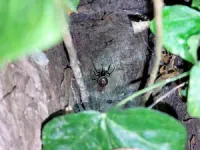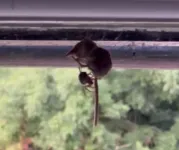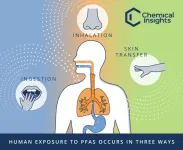(Press-News.org) In a bid to understand why mosquitoes may be more attracted to one human than another, Johns Hopkins Medicine researchers say they have mapped specialized receptors on the insects’ nerve cells that are able to fine-tune their ability to detect particularly “welcoming” odors in human skin.
Receptors on mosquito neurons have an important role in the insects’ ability to identify people who present an attractive source of a blood meal, according to Christopher Potter, Ph.D., associate professor of neuroscience at the Johns Hopkins University School of Medicine. “Understanding the molecular biology of mosquito odor-sensing is key to developing new ways to avoid bites and the burdensome diseases they cause,” he says.
Worldwide, mosquito-borne diseases such as malaria, dengue fever, and West Nile virus afflict 700 million people and kill 750,000 each year. Although mosquito control efforts using nets and pesticides have helped reduce the toll, the development of better repellants to sabotage odorant attraction remains a priority.
Mosquitoes detect odors mostly through their antennae, and scientists have long observed that variations in odors, heat, humidity and carbon dioxide are factors in attracting mosquitos to some individuals more than others.
But, says Potter, the insects use multiple senses to find hosts. Anopheles gambiae, a family of mosquitoes that cause malaria, for example, has three types of receptors that stud the surface of neurons in their organs that sense odor: odorant, gustatory and ionotropic receptors.
Odorant receptors, says Potter, are the most well studied by scientists and are thought to help mosquitoes distinguish between animals and humans. Gustatory receptors detect carbon dioxide. Ionotropic receptors respond to acids and amines, compounds found on human skin. It is thought that different levels of particular acids on human skin might be a reason for some people to be more attractive to mosquitoes than others, says Potter.
Because of the potential for ionotropic receptors to guide a mosquito to prefer one type of human skin over another, Potter and postdoctoral researchers Joshua Raji and Joanna Konopka looked for them in mosquito antenna.
In a report published in the Feb. 28 issue of Cell Reports, the researchers described their search for the receptors in segmented tube-like antennae of 10 female and 10 male mosquitoes.
Bites to human skin come from female mosquitoes, although some research indicates that males are also attracted to human odors.
To find neurons expressing ionotropic receptors in the antennae, the researchers used a technique called fluorescent in situ hybridization, which pinpoints not the receptors themselves, but genetic material called RNA, a cousin of DNA. Finding RNA linked to ionotropic receptors means that the neurons are highly likely to be producing such receptors.
The scientists thought they’d find similar numbers of ionotropic receptor-laden neurons in each of the antennae segments, but they found the majority of ionotropic receptors in the distal (farthest from the head) part of the antennae.
They also found, however, that the antennae had more ionotropic receptors in the proximal (near the head) part of the mosquitoes. All told, Potter says his team’s experiments show that mosquito antennae are more complex than we previously thought them to be, says Potter.
Ionotropic receptors are known to work with “partner” receptors to respond to odors, “kind of like a dance partner,” says Potter. In the current study, the researchers were able to identify some pairings of receptors that predicted if an ionotropic receptor would respond to acids or amines. They verified these predictions by using genetic engineering to visualize the responses of an ionotropic receptor called Ir41c in the mosquito. Ir41c-expressing neurons were activated by one type of amine as predicted, but were inhibited (turned off) by a different type of amine.
Potter suspects that the ability of ionotropic receptor-expressing neurons to be both activated and inhibited by odors may allow mosquitoes to increase the range of responses ionotropic receptors can play in odor detection and in driving behaviors. Future studies, he says, will focus on identifying the specific ionotropic receptors that cause mosquitoes to be attracted to human odors.
This research was supported by the National Institutes of Health (R01Al137078), the Department of Defense, the Johns Hopkins Postdoctoral Accelerator Award, the Johns Hopkins Malaria Research Institute, the Natural Science and Engineering Research Council and Bloomberg Philanthropies.
DOI: 10.1016/j.celrep.2023.112101
END
Researchers map mosquito cells that may help the insects choose tastiest humans
2023-02-21
ELSE PRESS RELEASES FROM THIS DATE:
US Census data vulnerable to attack without enhanced privacy measures
2023-02-21
Computer scientists at the University of Pennsylvania School of Engineering and Applied Science have designed a “reconstruction attack” that proves U.S. Census data is vulnerable to exposure and theft.
Aaron Roth, Henry Salvatori Professor of Computer & Cognitive Science in Computer and Information Science (CIS), and Michael Kearns, National Center Professor of Management & Technology in CIS, led a recent PNAS study demonstrating that statistics released by the U.S. Census Bureau can be reverse engineered to reveal ...
Excess nutrients lead to dramatic ecosystem changes in Cape Cod’s Waquoit Bay; the bay is a harbinger for estuaries worldwide, say researchers
2023-02-21
Woods Hole, Mass. (Feb. 21, 2023) -- When the Covid-19 pandemic hit in 2020 with associated travel restrictions, Matthew Long thought his students could shift their overseas research projects to instead study the seagrass meadow ecosystem in Waquoit Bay. It’s a shallow, micro-tidal estuary on the south side of Cape Cod in Massachusetts, near the Woods Hole Oceanographic Institution (WHOI) where Long is an associate scientist in the Marine Chemistry and Geochemistry Department.
However, when Long and his students looked for seagrass meadows where he had seen them in previous years, there were only a few shoots of dying Zostera marina eelgrass, ...
New AGA guideline recommends blood and stool tests for monitoring ulcerative colitis
2023-02-21
Bethesda, MD (Feb. 21, 2023) — In new evidence-based guidelines, the American Gastroenterological Association (AGA) recommends non-invasive biomarkers as a first-line strategy for monitoring many patients with ulcerative colitis (UC). These guidelines were published today in Gastroenterology.
The AGA guidelines outline use cases for three biomarkers that provide accurate insights into ulcerative colitis disease activity: serum C-reactive protein (CRP) (blood), fecal calprotectin (stool) and fecal lactoferrin (stool).
“For decades we have regarded endoscopy as the gold ...
RIT researcher awarded NSF CAREER funding to develop advanced computer memory and devices
2023-02-21
Kai Ni was awarded a National Science Foundation CAREER Award to improve computing memory through the use of ferroelectric materials and capacity.
The assistant professor of electrical and microelectronic engineering in RIT’s Kate Gleason College of Engineering, Ni has been at the forefront of advancing ferroelectric memory, a familiar but never widely adopted technology that has the potential to meet the growing demand for more energy-efficient computing performance.
“The appetite for semiconductors just keeps growing. With the data we are generating every day, we need ways to process ...
CHOP researchers develop first effective preclinical models for most common genetic cause of Leigh Syndrome
2023-02-21
Philadelphia, February 21, 2023 – Researchers from Children’s Hospital of Philadelphia (CHOP) developed two new zebrafish models for studying a specific genetic form of mitochondrial disease that represents the most common cause of Leigh syndrome. Using these models, the team identified two drugs already approved by the Food and Drug Administration (FDA) for other conditions that could be repurposed to treat this specific cause of Leigh syndrome. The findings were recently published in the journal Human Molecular Genetics.
SURF1 deficiency ...
Public lecture: how can we have a good future with artificial intelligence?
2023-02-21
Public lecture: how can we have a good future with artificial intelligence?AI expert and educator Professor Anikó Ekárt to discuss one of today’s most provocative topics
Lecture will take place on 28 February at Aston University
Talk to explore artificial intelligence’s capabilities, benefits and pitfalls.
The potential impact of artificial intelligence (AI) on our daily lives will be explored in a public lecture at Aston University.
The University is inviting the public onto its campus on Tuesday 28 February to hear Professor ...
Study finds parents serve as a safety net as grown kids navigate the workforce
2023-02-21
A new study underscores the role that parents play as a safety net for their young adult children as those children navigate the labor market, and highlights the challenges facing young adults who do not have access to parental support.
“In recent decades, we’ve seen a lot of changes in the labor market, from the decline of lifetime employment at one job to the rise of the so-called ‘gig economy,’” says Anna Manzoni, corresponding author of the study and an associate professor of sociology at North Carolina State University. “We wanted to see what role ...
Noble false widow spider found preying on pygmy shrew
2023-02-21
Scientists at University of Galway have published the first record of a noble false widow spider feeding on a pygmy shrew, a species of tiny mammal protected in Ireland.
The new study, recently published in the international journal Ecosphere, demonstrates further the potentially negative impact of the invasive and venomous noble false widow spider on native species.
A recording by Dawn Sturgess showing the spider interacting with the pygmy shrew be downloaded at https://bit.ly/3XPbDKU.
It is the first time a member of this family of spiders, ...
Starch gelatinization, retrogradation, and the world’s fluffiest white bread (video)
2023-02-21
WASHINGTON, Feb. 21, 2023 — If you want to make the fluffiest bread possible, you’re going to need to use chemistry. This week, we explore the science behind starch gelatinization, a phenomenon found in Chinese “tangzhong” and Japanese “yudane” techniques. Then, we put it to the test to see how much gelatinized starch it takes to make the fluffiest, tastiest and most stale-resistant loaf! https://youtu.be/3ziMBDPMuP8
Reactions is a video series produced by the American Chemical Society and PBS Digital Studios. Subscribe to ...
Chemical Insights Research Institute and Emory University’s Rollins School of Public Health team to study the human health impact of PFAS chemical exposure
2023-02-21
ATLANTA – Feb. 21, 2023 – Chemical Insights Research Institute (CIRI) of UL Research Institutes and Emory University's Rollins School of Public Health have announced upcoming research to study human exposure to per- and polyfluoroalkyl substances (PFAS). Data from the Centers for Disease Control and Prevention (CDC) show that approximately 97% of Americans have detectable PFAS levels in their blood. The joint study aims to understand how this exposure occurs and the potential health consequences.
Although humans may be exposed to PFAS by ingesting food or ...







